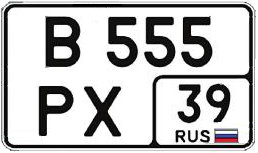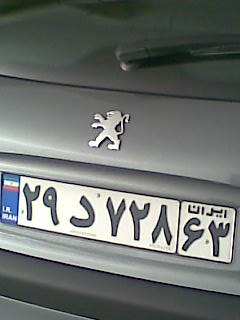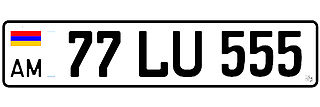
A vehicle registration plate, also known as a number plate, license plate or licence plate, is a metal or plastic plate attached to a motor vehicle or trailer for official identification purposes. All countries require registration plates for road vehicles such as cars, trucks, and motorcycles. Whether they are required for other vehicles, such as bicycles, boats, or tractors, may vary by jurisdiction. The registration identifier is a numeric or alphanumeric ID that uniquely identifies the vehicle or vehicle owner within the issuing region's vehicle register. In some countries, the identifier is unique within the entire country, while in others it is unique within a state or province. Whether the identifier is associated with a vehicle or a person also varies by issuing agency. There are also electronic license plates.

Number plates in Belgium are driver specific, meaning that they are transferred to a new vehicle from the owner's previous one.
Australian vehicle registration plates or number plates are issued by state, territory, and Commonwealth governments, and the armed forces of Australia. The plates are associated with a vehicle and are generally intended to last for the time the vehicle remains registered in the state, though as they become unreadable they may be remade with like for like replacement. Motor vehicle registration in Australia, can be renewed monthly, quarterly, half yearly or annually depending on the state or territory where the vehicle is registered.
The most common format for vehicle registration plates in Romania consists of black letters on white background in the format CC 12 ABC, where CC is a two letter county code, 12 is a two digit group, and ABC is a three letter group. For Bucharest, the format is B 12 ABC or B 123 ABC, where B is code for Bucharest city, 12 and 123 is a two or three digit group, and ABC is a three letter group. The left side of the plate bears a blue vertical strip displaying the 12 stars of the European Union and the country code of Romania (RO). Between 1992-2007 the band featured the Romanian flag instead of the 12 stars. All lettering comes from the Latin alphabet.
Austrian car number plates are mandatory vehicle registration plates displaying the registration mark of motor vehicles in Austria. They are used to verify street legality, proof of a valid liability insurance and to identify and recognise the vehicle.
Vehicle registration plates of Poland indicate the region of registration of the vehicle given the number plate.
In the United States, vehicle registration plates, known as license plates, are issued by a department of motor vehicles, an agency of the state or territorial government, or in the case of the District of Columbia, the district government. Some Native American tribes also issue plates. The U.S. federal government issues plates only for its own vehicle fleet and for vehicles owned by foreign diplomats. Until the 1980s, diplomatic plates were issued by the state in which the consulate or embassy was located.
A vehicle registration plate, also known as a number plate, license plate or licence plate, is a metal or plastic plate or plates attached to a motor vehicle or trailer for official identification purposes. The registration identifier is a numeric or alphanumeric code that uniquely identifies the vehicle within the issuing authority's database. In Europe most countries have adopted a format for registration plates that satisfies the requirements in the Vienna Convention on Road Traffic, which states that cross-border vehicles must display a distinguishing code for the country of registration on the rear of the vehicle. This sign may be an oval sticker placed separately from the registration plate, or may be incorporated into the plate. When the distinguishing sign is incorporated into the registration plate, it must also appear on the front plate of the vehicle, and may be supplemented with the flag or emblem of the national state, or the emblem of the regional economic integration organisation to which the country belongs. An example of such format is the common EU format, with the EU flag above the country code issued in EU member states.

Vehicle registration plates are the mandatory number plates used to display the registration mark of a vehicle, and have existed in Russia for many decades. Most motor vehicles which are used on public roads are required by law to display them. Having a number plate obstructed by snow, mud, paper, or any other tool that makes any of the digits and letters illegible is considered an administrative offense and results in a fine.
In the United States, the appearance of license plates is frequently chosen to contain symbols, colors, or slogans associated with the issuing jurisdiction, which are the 50 U.S. states, the District of Columbia, the five inhabited U.S. territories, and Native American tribes, each of which independently registers motor vehicles. Regular-issue license plates for passenger vehicles typically have six or seven characters, with vanity plates having up to eight characters in a few states.
Vehicle registration plates of Georgia are composed of an embossed serial of two letters, a hyphen, three numbers, a hyphen, and two letters, in black on a white background with a blue vertical strip on the left. The plates are issued in the Latin alphabet. Georgian registration plates are the same size as the most common European registration plate. All plates have the abbreviation "GE" in the lower left corner of the plate and the national flag in the upper left corner. This set of new style registration plates have been in use since 1 September 2014.
The vehicle registration plates of Cyprus are composed of three letters and three digits. A simple incremental numbering system is used; numbers run from 001 to 999 per letter sequence (alphabetic), so that, for example, the plate to be issued after MAA 999 would be MAB 001. However, registrants may be allowed to choose a number from available numbers in the extant letter sequence.

The government of the Republic of Abkhazia, which considers itself independent from Georgia, issues its own vehicle registration plates for the motor vehicles registered in the territory it controls. The design of the plates is based on that of Russian license plates, although Abkhazian plates lack the regional coding of Russian plates.

The current vehicle registration plate system of Cuba was introduced in May 2013. Current plates are European standard 520 mm × 110 mm, completely replacing the previous system introduced in 2002. The international vehicle registration code for Cuba is C.

Iranian license plates have had European standard dimensions since 2005. Each province in Iran has multiple unique, two-digit codes that are included at the right end of the license plates in a distinguished square outline, above which the word ایران or "Iran" has been written. A province's license plates will not be issued with a new code unless all possible combinations with the old code have been issued. In Tehran, the first code to be issued for the province was code 11, and subsequent codes all increased by 11 as well Ever since code 99 was fully issued, the new codes for Tehran have started from 10 and subsequently increased by 10. Most province codes increased by 10 based on the first code issued for their province. Khuzestan Province, for example, has been allocated codes 24 and 14, and code 24 will not be used before code 14 is fully issued. However, as codes started getting exhausted, numbers and letters have been assigned more liberally and without following this rule of thumb anymore

Vehicle registration plates of Armenia have black characters on a rectangular white background. They are composed of two or three numbers, two letters in the middle, and two other numbers. At the left side is located the international code "AM" with an oval car plaque and, sometimes, the national flag. Starting from 6 August 2014 a new design of license plates was implemented. The license plates have a national flag on the left side, a security hologram and a machinery readable Data Matrix Code.
Kyrgyz registration plates were first issued in 1980, when the country was still a republic of the Soviet Union. Despite having gained its independence in 1991, it continued to use the old Soviet plates until the introduction of the current format in 1994.
Tajik vehicle registration plates are registration plates for vehicles registered in the country.
Vehicle registration plates were used in the Soviet Union for registrations of automobiles, motorcycles, heavy machinery, special-use vehicles as well as construction equipment, military vehicles and trailers. Every vehicle registration plate contains a unique registration mark embossed on a metal plate or a plate made of other materials. All vehicles were required to display the plates on the front side and backside, with the exception of trailers and motorcycles, which were only required to display one on the backside.
Vehicle registration plates, commonly known as number plates, are the mandatory alphanumeric or numeric plates used to display the registration mark of a vehicle.








